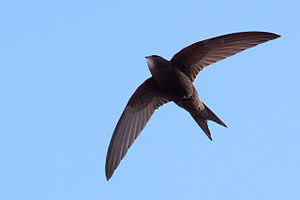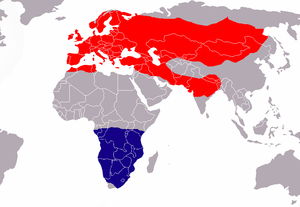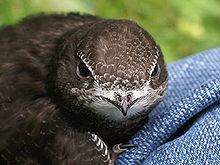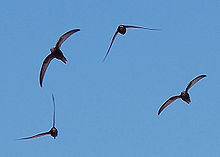- Common Swift
-
For the moth Korscheltellus lupulina, see Common Swift (moth).
Common Swift 
In Barcelona, Spain Conservation status Scientific classification Kingdom: Animalia Phylum: Chordata Class: Aves Order: Apodiformes Family: Apodidae Genus: Apus Species: A. apus Binomial name Apus apus
(Linnaeus, 1758)
Common Swift range The Common Swift (Apus apus) is a small bird, superficially similar to the Barn Swallow or House Martin. It is, however, completely unrelated to those passerine species, since swifts are in the separate order Apodiformes. The resemblances between the groups are due to convergent evolution reflecting similar life styles.
The scientific name comes from the Ancient Greek ἄπους, apous, meaning "without feet". These birds have very short legs which they use only for clinging to vertical surfaces (hence the German name Mauersegler, literally meaning "wall-glider"). They never settle voluntarily on the ground.
Contents
Taxonomy
The Common Swift was one of the many species described by Linnaeus in his Systema naturae in 1758. The scientific name comes from the Ancient Greek words α "without", and πούς, "feet". The predecessor of the Central European subspecies which lived during the last ice age has been described as Apus apus palapus.
Description
Common Swifts are 16–17 cm long with a wingspan of 38–40 cm[1] and entirely blackish-brown except for a small white or pale grey patch on their chins which is not visible from a distance. They have a short forked tail and very long swept-back wings that resemble a crescent or a boomerang.
The call is a loud scream in two different tone pitches, of which the higher one is from the female and the lower one from the male. They often form 'screaming parties' during summer evenings where about 10-15 gather and fly around in circles, all calling out to each other.
Behaviour
Migration
Like swallows, Common Swifts are migratory, and in midsummer they are found in Great Britain and northern Europe, while they winter much further south in southern Africa.
Breeding
Swifts will occasionally live in forests, but they have adapted more commonly to human sites and will build their nests in all suitable hollows in buildings, under window sills, in the corner rafters of wooden buildings, in chimneys, and in smokestacks. A swift will return to the same nesting site year after year, rebuilding its nest when necessary.
Young swifts in the nest can drop their body temperature and become torpid if bad weather prevents their parents from catching insects nearby.
Feeding
Swifts spend most of their lives in the air, living on the insects they catch in their beaks. They drink, feed, and often mate and sleep on the wing.[2]
Parasites
Swift nests commonly support populations of the Chewing Louse, Dennyus hirundinis and the Lousefly, Crataerina pallida.[3]
In heraldry
The heraldic bird known as the "martlet", which is represented without feet, may have been based on the swift, but is generally assumed to refer to the house martin; it was used for the arms of younger sons, perhaps because it symbolized their landless wandering.
Gallery
-
Video of a fight between two Swifts over a nest box
References
- ^ Common Swift - Apus Apus
- ^ Common Swift - Apus Apus
- ^ Tompkins D. M.; Jones T.; Clayton D. H. (1996). "Effect of vertically transmitted ctoparasites on the reproductive success of Swifts (Apus apus)". Functional ecology (Oxford: Blackwell Science, Oxford) 10 (6): 733–40. doi:10.2307/2390508. ISSN 0269-8463. JSTOR 2390508.
External links
- The Common Swift website
- APUSlife The Virtual Magazine of the Common Swift
- Birds of Britain: The Swift
- Live webcam pictures from a common swift nest
- Diet & Hand rearing
- London's Swifts Homepage
- Ageing and sexing (PDF) by Javier Blasco-Zumeta
- BirdLife International (2004). Apus apus. 2006. IUCN Red List of Threatened Species. IUCN 2006. www.iucnredlist.org. Retrieved on 11 May 2006. Database entry includes justification for why this species is of least concern
Categories:- IUCN Red List least concern species
- Apus
- Birds of Europe
- Birds of the Faroe Islands
- Birds of Turkey
- Birds of Iran
- Birds of Pakistan
- Birds of India
- Swifts
Wikimedia Foundation. 2010.






